This is Michael J. Wolfe’s fifth annual & comprehensive review of Super Bowl advertising effectiveness. Wolfe is CEO of Bottom-Line Analytics, an award-winning market mix modeling and advanced analytics expert who dives into every article he writes with a depth that provides deep learnings for all. Wolfe is a frequent contributor to the ABX Advisory and has given permission for this reprint of his recent article.

This is ABX and Bottom-Line Analytics fifth annual & comprehensive review of Super Bowl advertising effectiveness. In this report, we will address some specific questions:
- What are the historical trends in Super Bowl ad effectiveness and audience size?
- What are the trends in Super Bowl ad costs & what might this have to do with advertiser participation?
- How engaged was the Super Bowl Audience?
- For the 2022 Super Bowl advertisers, did these ads out-perform their branded ads from the prior year?
- Across 63 copy tests of Super Bowl ads, what factors explain & differentiate the best from the weaker performing TV commercials?
- Based on 2022 performance, what are the strengths & weaknesses of Super-Bowl advertising across audience demographics such as gender, age, income & ethnicity?
- Is there a “halo effect” from Super-Bowl ads, which results in higher advertising effectiveness throughout the year?
- Is there value in Super Bowl advertising? Under what conditions does it make sense and what conditions should it not be pursued?
Super Bowl Ad-Effectiveness Trends and Audience Size
The 2022 Super Bowl managed a decent improvement in audience size and a slight improvement in measured advertising effectiveness according to the ad-testing firm, ABX Advertising Benchmark Index and Nielsen. As shown in Exhibit 1, the viewing audience of 94 million for the prior Super Bowl 2021 was the lowest in ten years. This was undoubtedly affected by Covid. The 100.2 million audience in 2022 is still more than 10 million down from the high watermarks from 2013-2017.
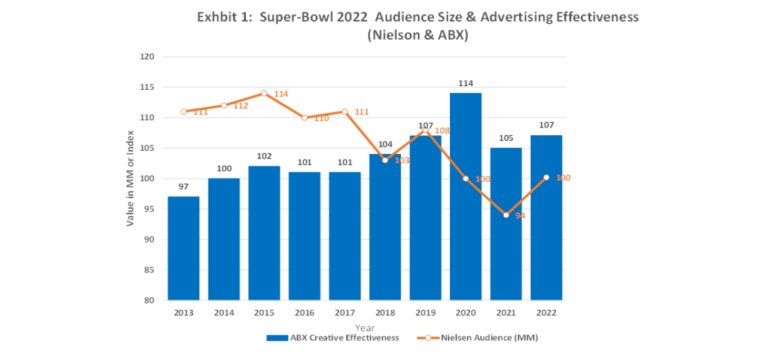
Super Bowl Ad Costs are very much an issue (Exhibit 2)
In 2022, Super Bowl ad costs jumped to $6.5 million per 30 Second Spot. This 18% increase was the largest in 15 years. Despite the steep costs, more brands advertised on the 2022 Super Bowl than the prior year. Still, perennial advertisers such as Jeep, McDonald’s, Cadillac & State Farm were drop-outs.
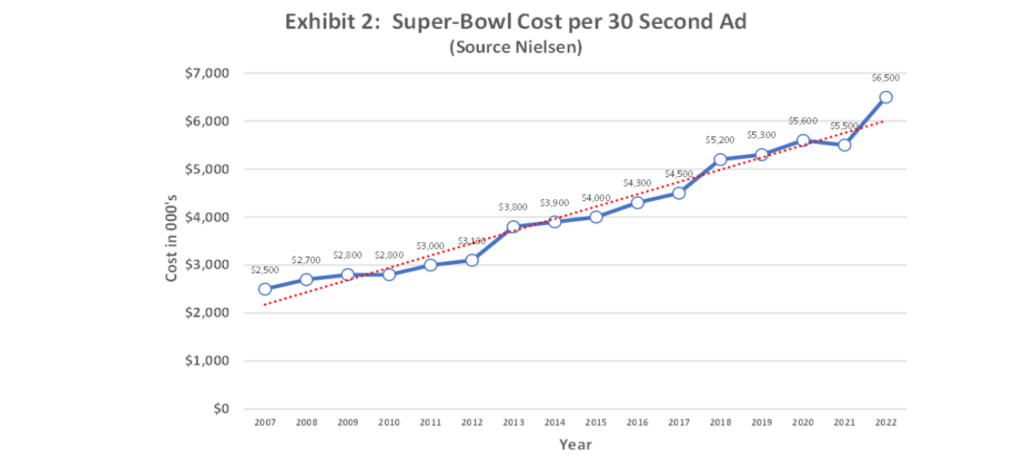
How Engaged was this year’s Super Bowl Audience? (Exhibit 3)
While 100 million viewers tuned into the 2022 Super Bowl via traditional TV, another 50 million watched the game via other video channels such as online or through streaming services. These latter two channels have, in fact, been the primary source for viewership growth, as the audience from linear TV has struggled to show any growth for the past three years. Even with total viewers of 150 million, evidence shows only about 59% of this audience was totally or mostly engaged in this event.
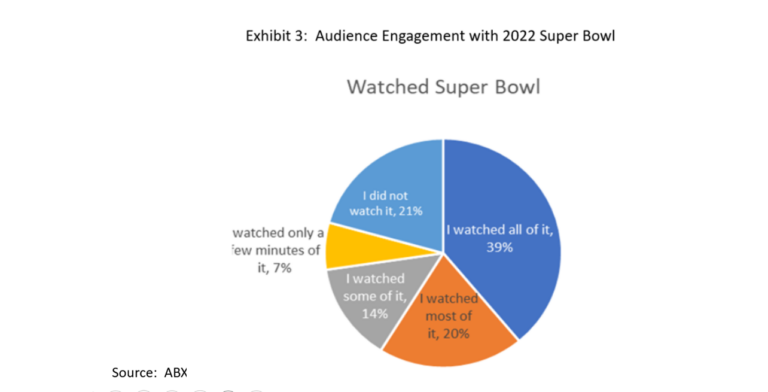
What Stands Out and Differentiates Top Performing Super Bowl Ads in 2022?
As you can see from Exhibit 4, we divide these diagnostics into those pertaining to the ads’ messaging & recall, as well as if or how the viewer was motivated or engaged by viewing the ad. What stands out for the top ads is likeability (this is associated with entertaining), improved brand reputation, high levels of ad-driven word-of-mouth and enough viewer interest to check out the brand online.
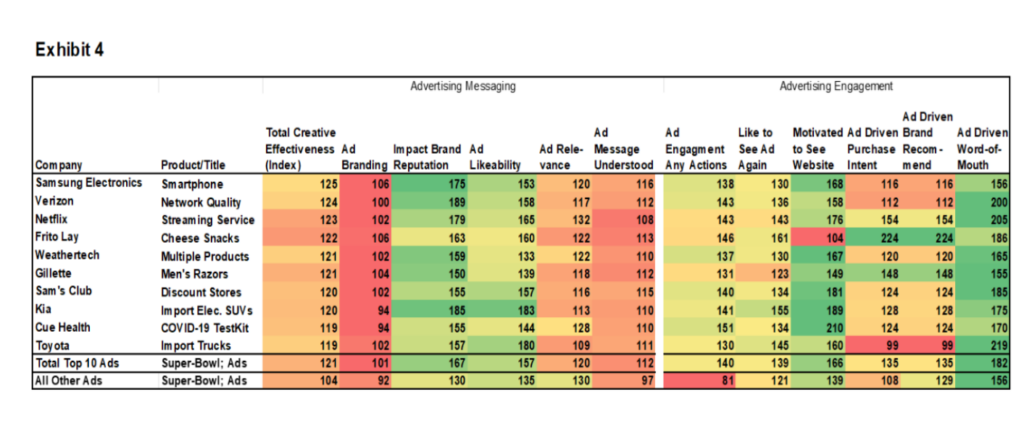
On Exhibit 5, we plot the total creative effectiveness scores for the 63 tested Super-Bowl ads. Here, you will see that the weakest of these ads differed from the best performing ads because they scored poorly on “clear branding” and “understanding the ad message”. It should be noted that my firm has engaged in a number of media-mix modeling projects using ABX data with media GRPs. Our findings reveal ads with scores in the green zone as effective, and in the yellow zone as not showing any evidence of impacting short-term sales. This aligns with the finding that many viewers of these ads do not recall the brand or core message of the ad.
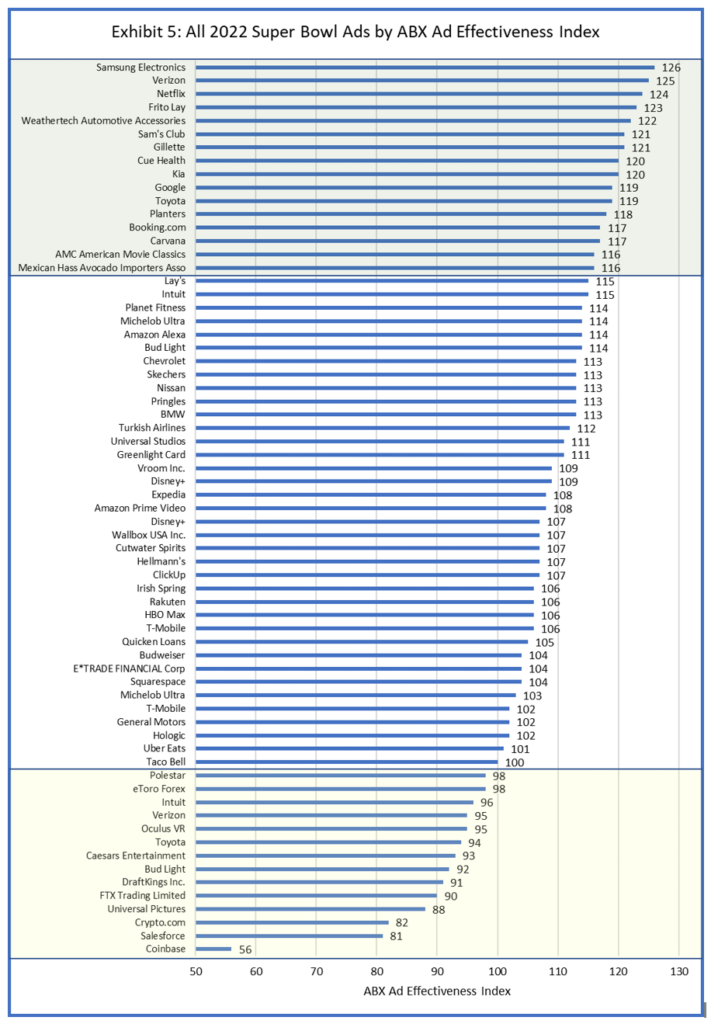
Are Super-Bowl Ads More Effective than ads at other times during the year?
Exhibit 6 looks at Super Bowl advertisers to see if their Super Bowl ads are better and more effective than ads these same advertisers run in the preceding year. The answer, here, is that there is not a significant difference in overall effectiveness, whatsoever; but there are some differences in the diagnostics. Super Bowl ads tend to be more likable (eg. entertaining), have a directionally more positive impact on “brand reputation” and drive more “word-of-mouth”. Also, at least for this group of ads, there is a stronger level of purchase intent towards the advertised brand.
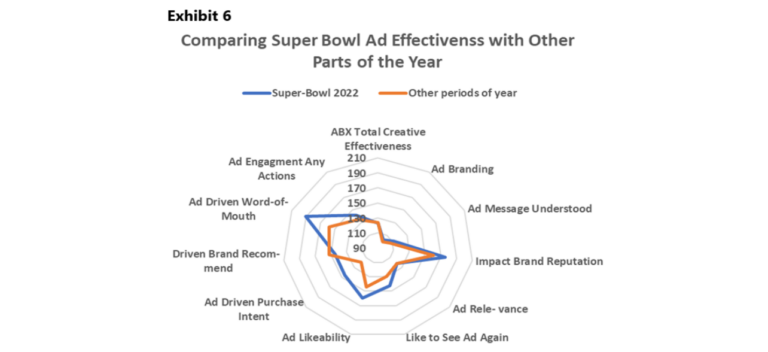
What are the trends, strengths and weaknesses of Super Bowl ads across audience demographic segments?
Exhibit 7 below shows overall ad effectiveness scores for the Super Bowl ads by year. This data suggests that engagement with Super Bowl ads is trending older, especially among the 35-49 Gen. X Group. There is no strong trend across income groups but slightly moving lower across higher incomes. While interest in Super Bowl ads have been strongly male, some significant gains were found among females. Advertisers should be concerned about the broad declines by ethnic groups, especially among Caucasians and Hispanics.
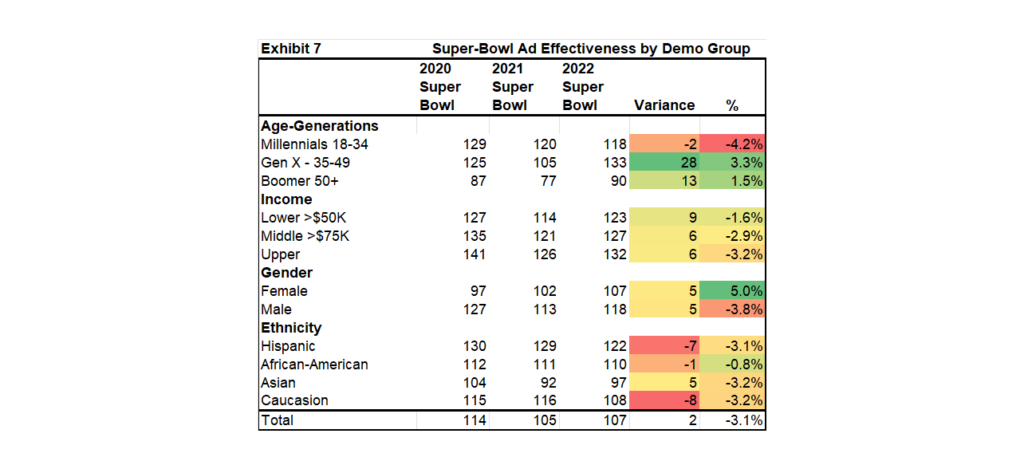
Does Super Bowl Advertising Benefit or Halo onto advertising “after” the Super Bowl?
Many advertisers believe that Super Bowl advertising has a long-term benefit. By improving the image of the advertised brand, this will improve how customers rate and respond to the brand’s future advertising.
In our 2021 Report, we investigated this issue by looking at advertising from the prior year’s Super Bowl (2020) and if the gains in ad effectiveness continued throughout the year. While we found some evidence of this, we could not conclude there was a positive “halo effect” from the Super-Bowl ads.
On Exhibit 8, we show results from tracking 2021 Super Bowl Ad Effectiveness. Evidence does not support the hypothesis that there is a long-term effect benefit to the advertised brands. In fact, overall ad effectiveness for these brands was slightly lower for the Super Bowl ads compared to the pre & post period.
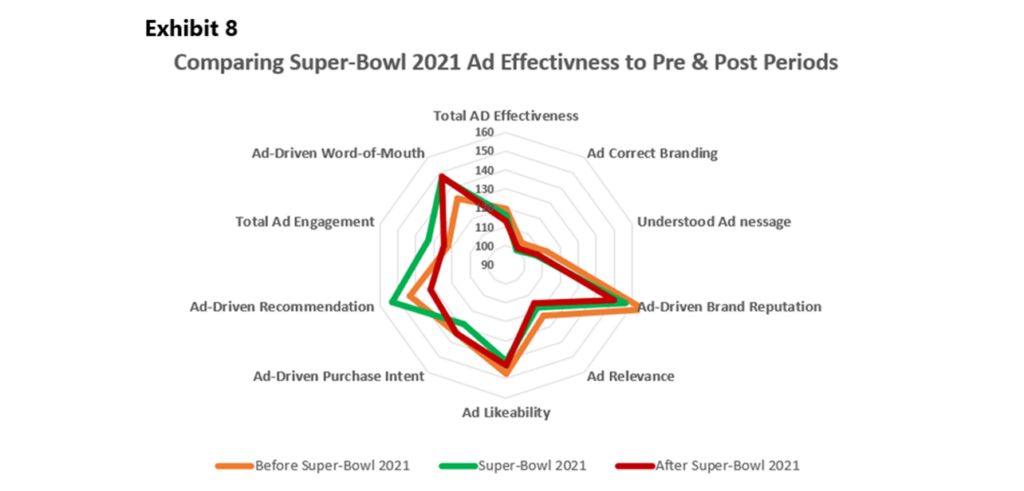
Is there a way to view these Super Bowl ads?
Below shows the video links to each of ABX’s top 10 Super-Bowl Ads for 2022. Click on Hyperlinks to view the ads.
1. Samsung Galaxy – 126
2. Verizon, Cable Guy – 125
3. Netflix, Movie Night– 124
4. Frito Lay, The Sloth – 123
5. Weathertech, Helicopters – 122
6. Gillette, Big Hair Guy – 121
7. Sam’s Club, Scan & Go -121
8. Kia, Robo Dog – 120
9. Cue Test, for Covid19 -120
10. Toyota, What’s Up Jones – 119
What did we learn from Super Bowl 2022 Advertising?
- Coming off a ten-year low in 2021, Nielsen’s TV audience measures show a rebound to 100.2 million for Super Bowl 2022. While this was a good increase, audience size remains below the higher watermark levels of 110 million + from 2013-17. This downward trend could be a reflection of the decline in linear TV viewing. There has been substantial growth in viewership from online and streaming video services. In fact, when including these channels, it is estimated that total viewership of the 2022 Super Bowl was closer to 150 million.
- In 2022, the cost of a 30-second Super Bowl TV spot increased to $6.5 million or 18%. This was the largest single-year increase in at least 15 years. The cost of these ads has risen more than 2X the general inflation rate over the past 15 years. Considering the difficulty of proving ROI from Super Bowl ads and the evidence that positive ROI does not exist for many, if not most of them, cost is an ever-increasing deterrent to making decisions to continue with Super-Bowl ad campaigns.
- Despite the atmospheric 150 million viewers the Super Bowl serves up, research indicates that only about 60% of the audience is reasonably engaged in the program. This could explain why about 1/3 of those viewed Super Bowl ads could not identify the brand being advertised or its core message. This means that spending on these brands was a complete waste.
- For those who argue that Super Bowl advertising is a long-term payout, we see no evidence that their post Super Bowl advertising receives a positive halo. In other words, Super Bowl advertising does not appear to drive improvement in the advertisers’ overall ad effectiveness on a forward basis.
- Super Bowl advertising has its own distinct qualities. More than other ads, they tend to benefit brand reputation and generate a lot of word-of-mouth for the advertisers. They tend to do this by increasing the likeability of the ad, which means that they are valued for their entertainment value. For the first time in 2022, Super Bowl ads also generated significantly higher “purchase intent” towards the advertised brand. That means that the likelihood of the ads generating positive ROI has improved!
- We see that advertising effectiveness is trending away from younger demographics groups and high growth ethnic groups, such as Hispanics. To consider the long-term value of Super Bowl advertising, these are the groups that advertisers should be attracting.
Which brands should consider doing a Super Bowl ad campaign?
- Brands which copy-test their ads prior to airing them. It is imperative that these ads have strong branding and are highly likable and entertaining. It is also important that the ads convey a positive brand image.
- You are a food or beverage brand which is consumed during the Super Bowl. This includes fast food, food delivery services, snacks and beverages. These products mostly scored well on ad effectiveness.
- Your brand is sports focused and spends a lot of its budget on sports sponsorships. This is probably the primary motivation for long-time advertisers like Anheuser Busch.
- You can measure & prove that your ad effectiveness is higher year-around when you advertise on the Super Bowl.
- Your brand has large marketing budgets and spends year-round on media. This budget should be at least 10x the cost of your Super Bowl Campaign.
- You are a new product or service who needs a big jolt of awareness to get your business off the ground.
Which brands should not consider a Super-Bowl Campaign:
- You are an ROI-Driven marketer who must show break-even or positive returns to your ad spending. The risk of this not happening is large and the task of proving positive ROI will be difficult.
- Your annual budget is small and a Super Bowl Campaign is going to consume a large portion of that budget (> 10%).
- You are not fact-driven and willing to test your ad concepts prior to the Super Bowl. Gut feelings too often will not be right.
